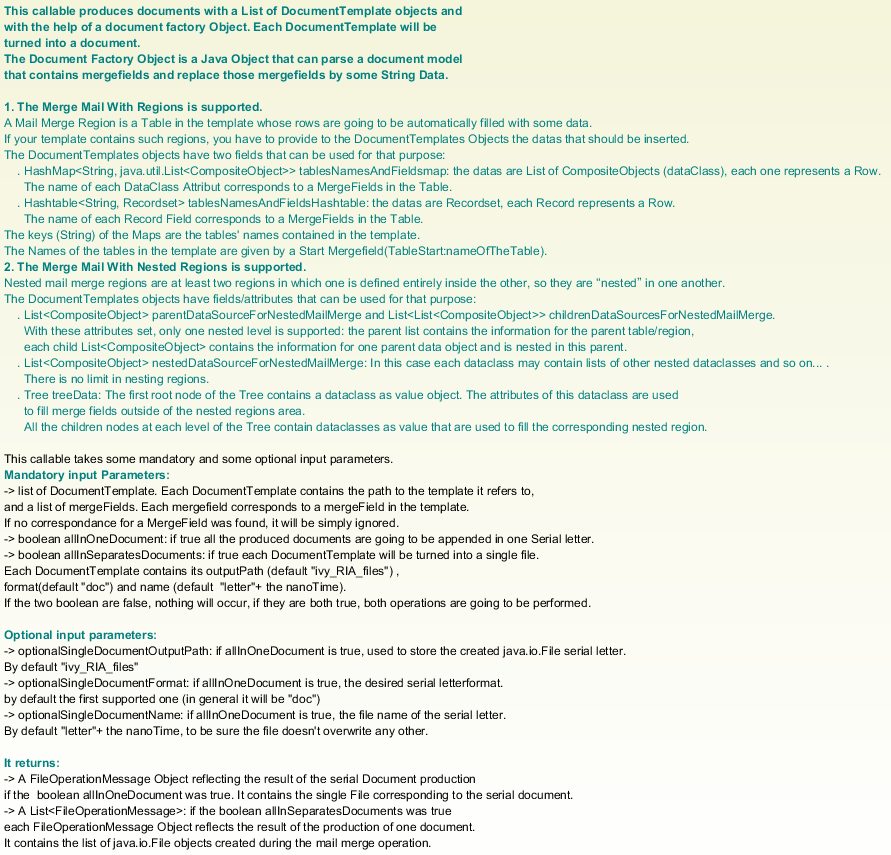Callable Processes
Two Callable Processes are available from the DocFactory project and at your service, to cover a maximum of your needs in the letter production. They use three kinds of Java Objects to perform their task.
Java Classes
The package ch.ivyteam.ivy.addons.docfactory contains the Java classes
of those objects.
TemplateMergeField
The TemplateMergeField class is the representation of a merge field in a template. It has two attributes: a name and a value. Both are of type String. The class provides information to the mail merge engine to fill the corresponding merge fields in the template.
Field |
Type |
Description |
|---|---|---|
mergeFieldName |
String |
Name of the merge field. If the mergeFieldName is in the form of “Image:ImageName” or “Image_ImageName” where “Image:” or “Image_” is constant, then this indicates that an image will be placed into the respective merge field. |
mergeFieldValue |
String |
The value of the merge field. If image merge fields are used, (see above), then this
indicates the path to the image, for example: |
There is one constructor: public TemplateMergeField(String mergeFieldName, String mergeFieldValue).
FileOperationMessage
The FileOperationMessage class conveniently returns the results of mail merging and file generation. It contains three variables:
Field |
Type |
Description |
|---|---|---|
message |
String |
The text message to return (like “File generation successful” or “An error occurred”…) |
type |
String |
Number indicating which kind of message it is (SUCCESS, ERROR or INFORMATION). The possible return values are available as static final constants on this class. |
files |
List<java.io.File> |
All the Files produced during the mail merge operation. They can be used for further actions like printing, editing, downloading…. |
There are two constructors: The default constructor
public FileOperationMessage() and public FileOperationMessage(String message,
List<File> files, int type)
DocumentTemplate
The DocumentTemplate class represents a whole letter or document to be generated. It contains all the necessary information to be able to generate a new document with a mail merge engine. The information is inserted into the following variables, each of which can be accessed through get/set methods:
Tip
For more information about the methods, please look at the JavaDoc.
Field |
Type |
Description |
|---|---|---|
templatePath |
String |
File path of the template to use for the mail merging. This path is on the Engine. |
outputPath |
String |
The path of the folder where to store the produced document after mail merging. |
outputName |
String |
The name of the file or document produced. |
outputFormat |
String |
The desired Format of the output document (doc, docx, etc.). |
mergeFields |
List<TemplateMergeField> |
The list of the merge fields: each merge field should be present in the template. The values of the merge fields will be inserted into the corresponding template merge fields. |
data |
CompositeObject (like a DataClass) |
The DocumentTemplate object accepts a DataClass as an alternative to a List of TemplateMergeFields. Each attribute of the dataclass is linked to a template merge field with the same name. The String value of the attribute is inserted into the corresponding merge field. |
documentFactory |
BaseDocFactory |
This is the engine responsible for the mail merge. For details, refer to the last section on this page. |
fileOperationMessage |
FileOperationMessage |
The FileOperationMessage returned by the mail merging operation. |
tablesNamesAndFieldsmap* |
java.util.HashMap<String, java.util.List<CompositeObject>> |
This parameter is used for mail merge with regions. This object consists of key/value pairs, where the keys (String) are the table start names and the lists of CompositeObjects contain the data. Each CompositeObject (i.e., DataClass) represents a row in a table. The value of the dataclass attributes whose names match merge field names of the table will used to fill these merge fields. |
tablesNamesAndFieldsHashtable* |
java.util.Hashtable<String, Recordset> |
This parameter is used for mail merge with regions. This object consists of key/value pairs, where the keys (String) are the table start names, and the recordsets contain the data for the corresponding tables. Each record represents a row in a table. A record value will be inserted in the merge field that corresponds to its field’s name. |
parentDataSourceForNestedMailMerge, childrenDataSourcesForNestedMailMerge |
List<CompositeObject> List<List<CompositeObject>> |
Used for mail merge with nested regions. With these attributes set, only one nested level is supported: The parent list contains the information for the parent table/region, each child List<CompositeObject> contains the information for one parent data object and is nested in this parent. |
nestedDataSourceFor |
List<CompositeObject> |
Used for mail merge with nested regions. Each dataclass may contain lists of other nested dataclasses and so on. There is no limit for nesting regions. |
treeData |
Tree |
Used for mail merge with nested regions. There is no limit for nesting regions. The data structure corresponding to the nested regions in the template is stored in a tree. The first root node of the tree contains a dataclass as its object value. The attributes of this dataclass are inserted into merge fields outside of the nested regions area. All the children nodes at each level of the tree contain dataclasses as values that are inserted into the corresponding nested region. |
* The two attributes tablesNamesAndFieldsmap and tablesNamesAndFieldsHashtable cannot be used together to perform mail merge with regions. If one is set, then the other one is cleared. So you have to decide if you use Recordsets or List of CompositeObjects to fill your merge regions.
There are several constructors; they are all documented in JavaDoc.
Callable Processes
Two callable processes are available to ease the use of the document factory. They are located in the DocFactory Functional Processes folder:
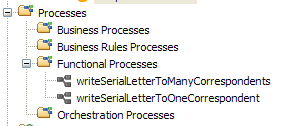
writeSerialLetterToOneCorrespondent
The Callable named writeSerialLetterToOneCorrespondent contains several callable subprocess starts.
The first one (writeSerialLetterToOneCorrespondant) allows writing a single document with a template by providing a single list of TemplateMergeField objects. Here is the description of this callable that you can find in the ivy process file:
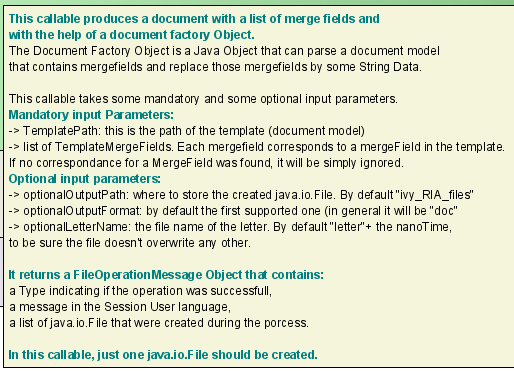
The second one (writeDocumentWithOneDataClass) allows writing a single document with a template by providing a CompositeObject (DataClass). Here is the description of this callable that you can find in the Axon Ivy process file:
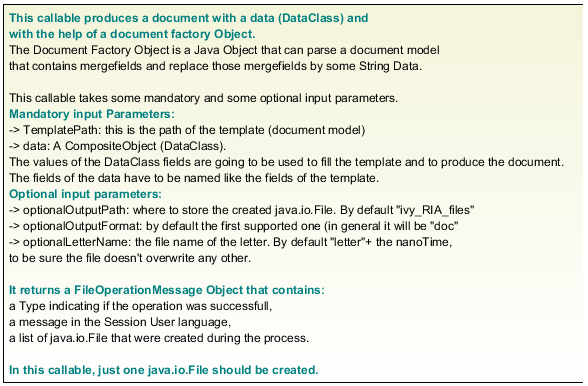
Other ones (writeDocumentWithMailMergeTable) allow writing a single document with a template that can contain merge mail with regions (tables). Here is the description of this callable that you can find in the Axon Ivy process file:
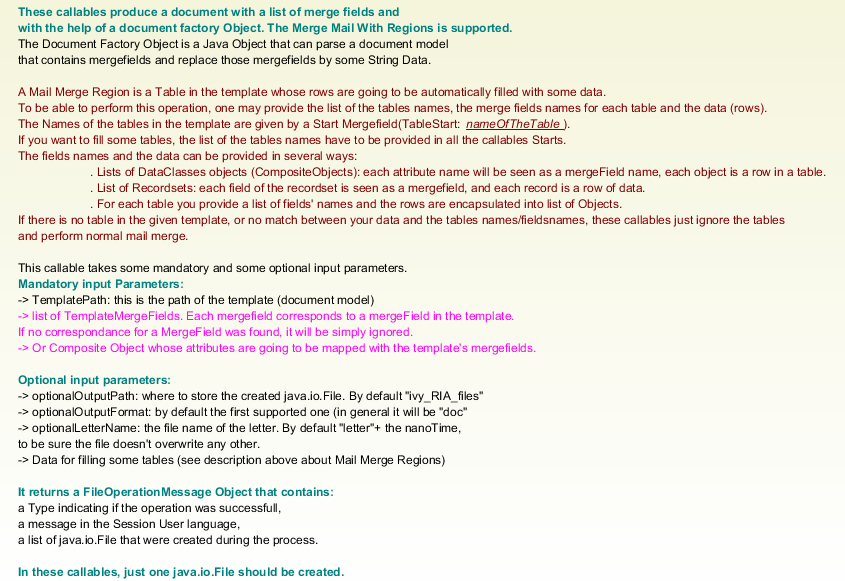
The last three allow writing a single document with a template that contains mail merge data with nested regions (tables).
writeDocumentWithMailMergeNestedTable(String,String,String,String, List<CompositeObject>,List<List<CompositeObject>>)
writeDocumentWithMailMergeNestedTableWithTree(String,String,String, String,Tree)
writeDocumentWithMailMergeNestedTableWithListOfDatas(String,String, String,String,CompositeObject, List<CompositeObject>)

writeSerialLetterToManyCorrespondents
The callable named writeSerialLetterToManyCorrespondents allows writing more than one document with a list of DocumentTemplate objects. Each DocumentTemplate object will produce a document. Mail merge with regions and mail merge with nested regions are now supported, because the DocumentTemplate Object encapsulates the necessary parameters to perform such merges (DocumentTemplate). Here is the description of this callable that you can find in the Axon Ivy process file:
